

Scientia Silvae Sinicae ›› 2023, Vol. 59 ›› Issue (8): 60-73.doi: 10.11707/j.1001-7488.LYKX20220709
Previous Articles Next Articles
Received:2022-10-20
Online:2023-08-25
Published:2023-10-16
Contact:
Junyang Song
E-mail:281168046@qq.com
CLC Number:
Sucheng He,Junyang Song. Characteristics and Mechanism of Seed Dormancy of Acer griseum[J]. Scientia Silvae Sinicae, 2023, 59(8): 60-73.
Table 1
Effects of low temperature stratification, embryo sectioning and different concentrations of gibberellin on the breaking of dormancy of A. griseum seeds"
| 低温层积 Low temperature stratification | 切离胚 Embryo sectioning | 赤霉素浓度 Concentrations of GA3/(mg·L–1) | 发芽率 Germination rate(%) |
| 否No | 否No | 0 | 0 |
| 否No | 否No | 200 | 0 |
| 否No | 否No | 400 | 0 |
| 否No | 否No | 800 | 0 |
| 否No | 是Yes | 0 | 0 |
| 否No | 是Yes | 200 | 0 |
| 否No | 是Yes | 400 | 0 |
| 否No | 是Yes | 800 | 0 |
| 是Yes | 否No | 0 | 0 |
| 是Yes | 是Yes | 0 | 0 |

Fig.1
Comparison of inhibitory effects of four extracts from A. griseum seeds on wheat seeds germination (A) Germination of wheat seeds on the third day; (B) Germination of wheat seeds on the 7th day. A1: Wing extract; A2: Outer seed coat extract; A3: Inner seed coat extract; A4: Dormant seed embryo extract; UP: Ultrapure water."

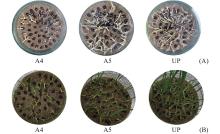
Fig.2
Comparison of inhibitory effects of dormancy embryo and dormancy broken embryo extract from A. griseum seeds on wheat seeds germination (A) Germination of wheat seeds on the third day; (B) Germination of wheat seeds on the 7th day. A4: Dormant seed embryo extract; A5: Break the dormant embryo extract; UP: Ultrapure water."


Fig.3
Effects of four extracts from dormant A. griseum seeds and extract from broken dormant A. griseum embryo on seeds germination of wheat (A) Germination vigor, (B) Germination rate, (C) Germination index. A1: Wing extract; A2: Outer seed coat extract; A3: Inner seed coat extract; A4: Dormant seed embryo extract; A5: Break the dormant embryo extract; UP: Ultrapure water. Different lowercase letters indicate highly significant differences between treatments at P<0.01 level."


Fig.4
Principal component analysis (PCA) of quality control (A) PCA of quality control in positive ion mode, (B) PCA of quality control in negative ion mode. CK: dormancy-broken embryo; T: dormancy embryo; QC: all sample mixing. The PC1 coordinate represents the first principal component, and the percentage in parentheses represents the contribution value of the first principal component to the sample difference. The PC2 coordinate represents the second principal component, and the percentage in parentheses represents the contribution of the second principal component to the sample difference. The colored points in the figure represent different samples respectively, and the closer the distance between the same group of samples, the better the sample repeatability. The more densely distributed QC samples are, the more reliable the data."
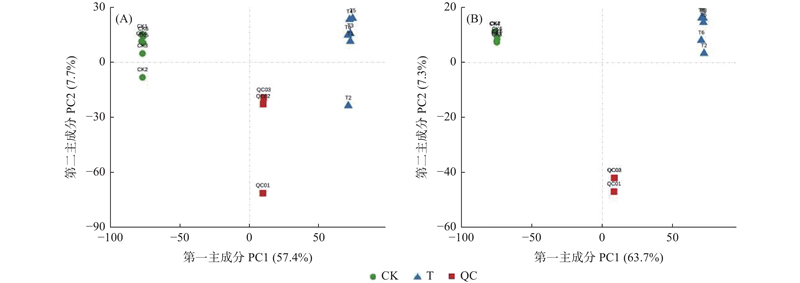

Fig.5
Sample correlation heat map (A) Sample correlation heat map in positive ion mode; (B) Sample correlation heat map in negative ion mode. Each row or column in the figure represents a sample, and the value in each cell represents the Pearson correlation coefficient of the corresponding two samples. The closer the value is to 1, the darker the color, the stronger the correlation between the two samples."
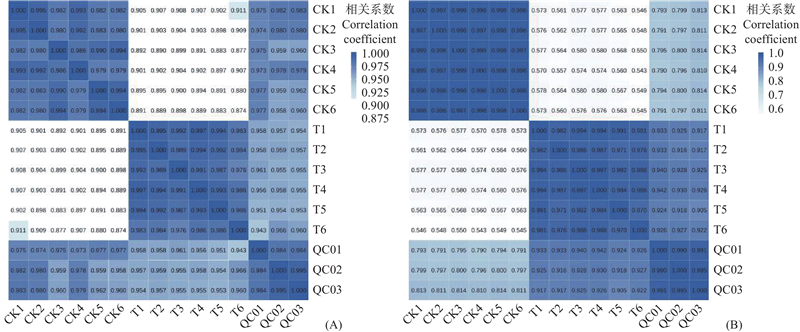
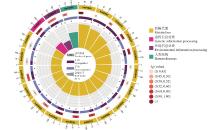
Fig.7
KEGG enrichment cycle chart The first circle: the top 20 pathways have been enriched, and the scale outside the circle refers to the number of differential metabolites;Different colors represent different A class. Circle 2: The number and Q value of the pathway in the background of the differential metabolites;The more the background number of differential metabolites, the longer the bar, the smaller the Q value, the redder the color. Circle 3: Bar chart of up-down-regulated differential metabolites proportion, dark purple represents up-regulated differential metabolites proportion, light purple represents down-regulated differential metabolites proportion; The specific values are shown below. Circle 4: RichFactor value of each pathway (the number of differential metabolites in the pathway divided by all the numbers in the pathway), background grid line, each grid represents 0.1."

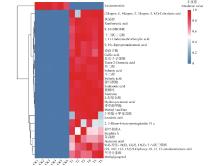
Fig.8
Differences in multiples (| log2FC |) Top20 metabolites clustering heat map In the figure, each row represents a metabolite, and each column represents a sample. 20 metabolites are standardized by R-package PheATMap (V1.0.12) (Kolde et al., 2018) for data Z-score, and then cluster analysis is performed and heatmap is drawn, which can visually show the expression rules of metabolites in the sample. The redder the color, the higher the abundance of metabolites. The bluer the color, the lower the metabolite abundance. The metabolites and samples were clustered according to their metabolite abundance, and the expression patterns of samples or metabolites under the same branch were more similar."

Table 2
Different multiples (|log2FC|) Top20 significant differences metabolites"
| 二级谱图匹配的 差异代谢物 Differences metabolites(MS2) | 化学物质登录号 CAS | 代谢物的分类 CLASS | 对照组(CK)积分定量值均值 Control_mean | 处理组(T)积分定量值均值 Case_mean | 差异倍数取log2 log2FC(case_mean/control_mean) |
| 2-羟基辛酸 Hydroxyoctanoic acid | 617-73-2 | 脂肪酰基 Fatty acyls | 1 | 116 323 933.50± 3 275 143.49 | 26.79 |
| 甲基生姜酚 Methylgingerol | — | 苯及其取代衍生物 Benzene and substituted derivatives | 1 | 51 566 708.15± 7 972 029.56 | 25.62 |
| 黄尿酸 Xanthurenic acid | 59-00-7 | 喹啉及其衍生物 Quinolines and derivatives | 1 | 33 927 291.88± 1 936 667.29 | 25.02 |
| 反式-2-辛烯酸 trans-2-Octenoic acid | 1871-67-6 | 脂肪酰基Fatty acyls | 1 | 25 985 461.12± 1 572 720.82 | 24.63 |
| 茉莉酸 Jasmonic acid | 59366-47-1 | 脂肪酰基 Fatty acyls | 1 | 24 092 770.25± 5 100 433.30 | 24.52 |
| 十三碳二元酸 1,11-Undecanedicarboxylic acid | 505-52-2 | 脂肪酰基 Fatty acyls | 1 | 18 552 823.64± 1 485 075.26 | 24.15 |
| 香草酸甲酯 Methyl vanillate | 3943-74-6 | 苯及其取代衍生物 Benzene and substituted derivatives | 1 | 17 917 489.67± 659 781.08 | 24.09 |
| 甜叶菊素A Sterebin A | 107647-14-3 | 孕烯醇酮脂类 Prenol lipids | 29 979.24± 20 623.82 | 28 021 234.01± 8 625 740.76 | 9.87 |
| 9,10-DHOME | — | 脂肪酰基 Fatty acyls | 273 046.59± 60 964.19 | 203 012 632.00± 15 799 278.61 | 9.54 |
| 没食子酸 Gallic acid | 149-91-7 | 苯及其取代衍生物 Benzene and substituted derivatives | 366 515.84± 124 845.54 | 234 320 907.50± 22 477 504.64 | 9.32 |
| 黄嘌呤 Xanthine | 69-89-6 | 咪唑并嘧啶类 Imidazopyrimidines | 200 441.72± 64 282.21 | 84 786 371.81± 2 852 164.17 | 8.72 |
| (2'E,4'Z,7'Z,8E)-Colnelenic acid | — | — | 120 076.71± 153 245.34 | 36 596 004.06± 10 850 047.06 | 8.25 |
| Lusitanicoside | 499-35-4 | 含氧有机物 Organooxygen compounds | 16 050 537.74± 1 297 721.17 | 68 719.84± 18 060.10 | ?7.87 |
| 辛二酸 Suberic acid | 505-48-6 | 脂肪酰基 Fatty acyls | 182 053.34± 83 626.64 | 39 659 265.40± 1 759 173.88 | 7.77 |
| 癸二酸 Sebacic acid | 111-20-6 | 脂肪酰基 Fatty acyls | 112 787.29± 63 607.65 | 19 396 356.98± 963 237.47 | 7.43 |
| 2,3-Dinor-6-keto-prostaglandin F1 a | — | 脂肪酰基 Fatty acyls | 302 167.62± 55 097.29 | 48 728 392.67± 19 852 430.85 | 7.33 |
| 2-羟基-4-甲基戊酸 Leucinic acid | 498-36-2 | 脂肪酰基 Fatty acyls | 856 742.28± 479 120.63 | 125 609 896.80± 55 570 190.11 | 7.20 |
| 9(S)-羟基-10(E),12(Z),15(Z)-十八碳三稀酸 (9S,10E,12Z,15Z)-9-Hydroxy-10,12,15-octadecatrienoic acid | — | — | 294 080.13± 47 110.04 | 31 460 665.89± 5 505 953.97 | 6.74 |
| 9,10-Epoxyoctadecenoic acid | — | 脂肪酰基 Fatty acyls | 6 817 811.33± 1 794 368.54 | 683 861 405.70± 61 296 093.44 | 6.65 |
| 瑟丹酮酸 Sedanonic acid | 6697-07-0 | 生酮酸及其衍生物 Keto acids and derivatives | 323 831.19± 169 883.62 | 31 587 321.59± 2 416 888.82 | 6.61 |
| 曹 山, 蒋璐瑶, 李丽红, 等. 毛果杨中链酰基辅酶A合成酶的克隆及酶学分析. 北京林业大学学报, 2016, 38 (7): 9- 15. | |
| Cao S, Jiang L Y, Li L H, et al. Cloning and enzymatic analysis of medium-chain acyl coenzyme A synthetase in Populus trichocarpa . Journal of Beijing Forestry University, 2016, 38 (7): 9- 15. | |
| 陈 丽, 李 冰, 王 梅, 等. 血皮槭的愈伤组织培养研究. 北方园艺, 2010, (8): 170- 172. | |
| Chen L, Li B, Wang M, et al. Study on callus culture of Acer griseum . Northern Horticulture, 2010, (8): 170- 172. | |
| 陈 朋, 于雪丹, 张川红, 等. 中国特有种血皮槭的天然更新. 林业科学, 2013, 49 (3): 159- 164. | |
| Chen P, Yu X D, Zhang C H, et al. Natural regeneration of Acer griseum, an endemic species in China . Scientia Silvae Sinicae, 2013, 49 (3): 159- 164. | |
| 杜丽雁, 张春涛, 高 强, 等. 血皮槭播种育苗技术. 林业实用技术, 2005, (3): 24. | |
| Du L Y, Zhang C T, Gao Q, et al. Sowing and cultivation technique of Acer griseum . Forest Science and Technology, 2005, (3): 24. | |
| 付其迪. 2020. 血皮槭叶绿体基因组变异及与近缘种系统进化分析. 北京: 中国林业科学研究院. | |
| Fu Q D. 2020. Variation of chloroplast genomes in Acer griseum and its phylogenetic relationship with related species. Beijing: Chinese Academy of Forestry.[in Chinese] | |
| 郭幸飞, 乔 琦, 李 婷. 特有珍稀植物血皮槭种子的生物学特征和贮藏特性研究. 种子, 2017, 36 (12): 20- 24. | |
| Guo X F, Qiao Q, Li T. The study on the seed biology and seed storage characteristics of Acer griseum, an endemic and rare plant in China . Seed, 2017, 36 (12): 20- 24. | |
| 孙佳伟, 郑勇奇, 于雪丹, 等. 濒危植物血皮槭花部特征和交配系统. 林业科学, 2022, 58 (6): 47- 55. | |
| Sun J W, Zheng Y Q, Yu X D, et al. Floral traits and mating system of endangered species Acer griseum . Scientia Silvae Sinicae, 2022, 58 (6): 47- 55. | |
| 孙 圣. 2014. 基于SSR标记的血皮槭天然群体遗传变异研究. 北京: 中国林业科学研究院. | |
| Sun S. 2014. Study on genetic variation of natural populations in Acer griseum based on SSR markers. Beijing: Chinese Academy of Forestry.[in Chinese] | |
| 王佳慧. 2015. 特有濒危种血皮槭天然群体生长状况及分子谱系地理初步研究. 北京: 中国林业科学研究院. | |
| Wang J H. 2015. Preliminary study on growth performance and molecular phylogeography of natural populations in an endangered maple, Acer griseum (Dicotyledoneae: Sapindaceae), endemic to China. Beijing: Chinese Academy of Forestry.[in Chinese] | |
| 汪 松, 解 焱. 2004. 中国物种红色名录. 第一卷, 红色名录. 北京: 高等教育出版社. | |
| Wang S, Xie Y. 2004. China species red list.Vol.1 Beijing: Higher Education Press.[in Chinese] | |
| 叶学敏. 2017. 濒危植物血皮槭种群动态预测及潜在适生区模拟研究. 北京: 中国林业科学研究院. | |
| Ye X M. 2017. Prediction of population dynamics and simulation of potentially suitable distribution in endangered species Acer griseum. Beijing: Chinese Academy of Forestry.[in Chinese] | |
| 张川红, 王佳慧, 于雪丹, 等. 特有种野生血皮槭的生长状况. 林业科学研究, 2015, 28 (3): 421- 425. | |
| Zhang C H, Wang J H, Yu X D, et al. Growth performance of wild paperbark maple (Acer griseum) . Forest Research, 2015, 28 (3): 421- 425. | |
| 张川红, 郑勇奇, 吴 见, 等. 血皮槭种子休眠机制研究. 植物研究, 2012, 32 (5): 573- 577. | |
| Zhang C H, Zheng Y Q, Wu J, et al. Mechanisms of seed dormancy of Acer griseum . Bulletin of Botanical Research, 2012, 32 (5): 573- 577. | |
| 中国科学院中国植物志编辑委员会. 1981. 中国植物志, 第46卷. 北京: 科学出版社. | |
| Flora Reipublicae Popularis Sinicae Editorial Committee of Chinese Academy of Sciences. 1981. Flora Reipublicae Popularis Sinicae, 46. Beijing: Science Press.[in Chinese] | |
| Alamillo J M, Díaz-Leal J L, Sánchez-Moran M V, et al. 2010. Molecular analysis of ureide accumulation under drought stress in Phaseolus vulgaris L. Plant, Cell & Environment, 33(11): 1828−1837. | |
| Baskin J M, Baskin C C. 1998. Seeds–ecology, biogeography, and evolution of dormancy and germination. San Diego, CA, USA: Academic Press. | |
|
Baskin J M, Baskin C C. A classification system for seed dormancy. Seed Science Research, 2004, 14 (1): 1- 16.
doi: 10.1079/SSR2003150 |
|
|
Berestetzky V, Dathe W, Daletskaya T, et al. Jasmonic acid in seed dormancy of Acer tataricum . Biochemie Und Physiologie Der Pflanzen, 1991, 187 (1): 13- 19.
doi: 10.1016/S0015-3796(11)80178-2 |
|
|
Bylesjo M, Rantalainen M, Cloarec O, et al. OPLS discriminant analysis: combining the strengths of PLS-DA and SIMCA classification. Journal of Chemometrics, 2006, 20, 341- 351.
doi: 10.1002/cem.1006 |
|
| Chang Y W, Zhao C X, Zhu Z, et al. Metabolic profiling based on LC/MS to evaluate unintended effects of transgenic rice with cry1Ac and sck genes . Plant Molecular Biology, 2012, 78 (4/5): 477- 487. | |
|
Chase M W, Christenhusz M J M, Fay M F, et al. An update of the Angiosperm Phylogeny Group classification for the orders and families of flowering plants: APG IV. Botanical Journal of the Linnean Society, 2016, 181 (1): 1- 20.
doi: 10.1111/boj.12385 |
|
| Corbineau F, Lecat S, Côme D. Dormancy of three cultivars of oat seeds (Avena sativa L.) . Seed Science & Technology, 1986, 14, 725- 735. | |
|
Corbineau F, Rudnicki R M, CoMe D. The effects of methyl jasmonate on sunflower (Helianthus annuus L.) seed germination and seedling development . Plant Growth Regulation, 1988, 7 (3): 157- 169.
doi: 10.1007/BF00028238 |
|
|
Dunn W B, Broadhurst D, Begley P, et al. Procedures for large-scale metabolic profiling of serum and plasma using gas chromatography and liquid chromatography coupled to mass spectrometry. Nature Protocols, 2011, 6 (7): 1060- 1083.
doi: 10.1038/nprot.2011.335 |
|
|
Fernández-Valverde M, Reglero A, Martinez-Blanco H, et al. Purification of Pseudomonas putida acyl coenzyme A ligase active with a range of aliphatic and aromatic substrates . Applied and Environmental Microbiology, 1993, 59(4), 1149- 1154.
doi: 10.1128/aem.59.4.1149-1154.1993 |
|
|
Finch-Savage W E, Leubner-Metzger G. Seed dormancy and the control of germination. New Phytologist, 2006, 171(3), 501- 523.
doi: 10.1111/j.1469-8137.2006.01787.x |
|
|
Finkelstein R, Reeves W, Ariizumi T, et al. Molecular aspects of seed dormancy. Annual Review of Plant Biology, 2008, 59, 387- 415.
doi: 10.1146/annurev.arplant.59.032607.092740 |
|
|
Fujihara S, Yamaguchi M. Effects of allopurinol [4-hydroxypyrazolo (3, 4-d) pyrimidine] on the metabolism of allantoin in soybean plants. Plant Physiology, 1978, 62(1), 134- 138.
doi: 10.1104/pp.62.1.134 |
|
|
Fulda M, Shockey J, Werber M, et al. Two long-chain acyl-CoA synthetases from Arabidopsis thaliana involved in peroxisomal fatty acid beta-oxidation . Plant Journal, 2002, 32(1), 93- 103.
doi: 10.1046/j.1365-313X.2002.01405.x |
|
| Gao F, Ayele B T. Functional genomics of seed dormancy in wheat: advances and prospects. Frontiers in Plant Science, 2014, 5, 458. | |
|
Gleiser G, Picher M C, Veintimilla P, et al. Seed dormancy in relation to seed storage behaviour in Acer . Botanical Journal of the Linnean Society, 2004, 145(2), 203- 208.
doi: 10.1111/j.1095-8339.2003.00276.x |
|
|
Graeber K, Nakabayashi K, Miatton E, et al. Molecular mechanisms of seed dormancy. Plant, Cell & Environment, 2012, 35(10), 1769- 1786.
doi: 10.1111/j.1365-3040.2012.02542.x |
|
|
Holdsworth M J, Bentsink L, Soppe W J J. Molecular networks regulating Arabidopsis seed maturation, after-ripening, dormancy and germination. New Phytologist, 2008, 179(1), 33- 54.
doi: 10.1111/j.1469-8137.2008.02437.x |
|
|
Ishimata N, Ito H, Tai A. Structure-activity relationships of vanillic acid ester analogs in inhibitory effect of antigen-mediated degranulation in rat basophilic leukemia RBL-2H3 cells. Bioorganic & Medicinal Chemistry Letters, 2016, 26(15), 3533- 3536.
doi: 10.1016/j.bmcl.2016.06.028 |
|
|
Kanehisa M, Goto S. KEGG: kyoto encyclopedia of genes and genomes. Nucleic Acids Research, 2000, 28(1), 27- 30.
doi: 10.1093/nar/28.1.27 |
|
|
Kasuya F, Igarashi K, Fukui M. Inhibition of a medium chain acyl-CoA synthetase involved in glycine conjugation by carboxylic acids. Biochemical Pharmacology, 1996, 52(10), 1643- 1646.
doi: 10.1016/S0006-2952(96)00563-1 |
|
| Kolde R, Kolde M R. 2018. Package ‘pheatmap’. R Package, 1. | |
|
Kong L, Wang F, Si J, et al. Water-soluble phenolic compounds in the coat control germination and peroxidase reactivation in Triticum aestivum seeds . Plant Growth Regulation, 2008, 56(3), 275- 283.
doi: 10.1007/s10725-008-9307-2 |
|
|
Kuras M. Cytochemical localization of phenolic compounds in columella cells of the root cap in seeds of Brassica napus—changes in the localization of phenolic compounds during germination . Annals of Botany, 1999, 84(2), 135- 143.
doi: 10.1006/anbo.1999.0884 |
|
| Lenoir C, Corbineau F, Côme D. Barley (Hordeum vulgare) seed dormancy as related to glumella characteristics . Physiologia Plantarum, 2010, 68(2), 301- 307. | |
|
Lisec J, Schauer N, Kopka J, et al. Gas chromatography mass spectrometry-based metabolite profiling in plants. Nature Protocols, 2006, 1(1), 387- 396.
doi: 10.1038/nprot.2006.59 |
|
|
Mothes K. The metabolism of urea and ureides. Canadian Journal of Botany, 1961, 39 (7): 1785- 1807.
doi: 10.1139/b61-158 |
|
|
Naseri B, Tabari M, Phartyal S S, et al. Deep physiological dormancy in seeds of Balkan maple (Acer hyrcanum): a rare tree in the Hyrcanian Mountain forests of Iran . Seed Science and Technology, 2018, 46(3), 473- 482.
doi: 10.15258/sst.2018.46.3.04 |
|
|
Nelson S K, Ariizumi T, Steber C M. Biology in the dry seed: transcriptome changes associated with dry seed dormancy and dormancy loss in the Arabidopsis GA-insensitive sleepy1-2 mutant . Frontiers in Plant Science, 2017, 8, 2158.
doi: 10.3389/fpls.2017.02158 |
|
|
Nojavan-Asghari M, Ishizawa K. Inhibitory effects of methyl jasmonate on the germination and ethylene production in cocklebur seeds. Journal of Plant Growth Regulation, 1998, 17(1), 13- 18.
doi: 10.1007/PL00007006 |
|
| Nonogaki H. Seed dormancy and germination-emerging mechanisms and new hypotheses. Frontiers in Plant Science, 2014, 5, 233. | |
|
Nourimand M, Todd C D. There is a direct link between allantoin concentration and cadmium tolerance in Arabidopsis . Plant Physiology and Biochemistry, 2019, 135, 441- 449.
doi: 10.1016/j.plaphy.2018.11.016 |
|
| Oracz K, Karpiński S. Phytohormones signaling pathways and ROS involvement in seed germination. Frontiers in Plant Science, 2016, 7, 864. | |
| Pawłowski T A. Proteome analysis of Norway maple (Acer platanoides L.) seeds dormancy breaking and germination:influence of abscisic and gibberellic acids . BMC Plant Biology, 2009, 9, 48. | |
| Phartyal S S, Thapliyal R C, Nayal J S, et al. 2003. Seed dormancy in Himalayan maple (Acer caesium) II: bioassay of inhibitors. Seed Science and Technology, 31(1): 13−20. | |
|
Pinfield N J, Dungey N O. Seed dormancy in Acer: an assessment of the rôle of the structures covering the embryo . Journal of Plant Physiology, 1985, 120(1), 65- 81.
doi: 10.1016/S0176-1617(85)80123-1 |
|
| Pinfield N J, Stutchbury P A. 1990b. Seed dormancy in Acer: the role of testa-imposed and embryo dormancy in Acer velutinum. Annals of Botany, 66(2): 133−137. | |
|
Pinfield N J, Stutchbury P A, Bazaid S A, et al. Abscisic acid and the regulation of embryo dormancy in the genus Acer . Tree Physiology, 1990a, 6(1), 79- 85.
doi: 10.1093/treephys/6.1.79 |
|
|
Qi M Q, Upadhyaya M K, Furness N H, et al. Mechanism of seed dormancy in Cynoglossum officinale L . Journal of Plant Physiology, 1993, 142(3), 325- 330.
doi: 10.1016/S0176-1617(11)80430-X |
|
| Reinbothe H. 1962. Urea, ureidea, and guanidines in plants. Annual Review Plant Physiology, 13: 129−150. | |
|
Saccenti E, Hoefsloot H C J, Smilde A K, et al. Reflections on univariate and multivariate analysis of metabolomics data. Metabolomics, 2014, 10(3), 361- 374.
doi: 10.1007/s11306-013-0598-6 |
|
|
Sińska I, Gladon R J. Ethylene and the removal of embryonal apple seed dormancy. HortScience, 1984, 19(1), 73- 75.
doi: 10.21273/HORTSCI.19.1.73 |
|
| Steinberg S J, Morgenthaler J, Heinzer A K, et al. Very long-chain acyl-CoA synthetases. Human "bubblegum" represents a new family of proteins capable of activating very long-chain fatty acids. Journal of Biological Chemistry, 2000, 275 (45): 35162- 35169. | |
| Thevenot E A. 2016. ropls: PCA, PLS (-DA) and OPLS (-DA) for multivariate analysis and feature selection of omics data. https://bioconductor.statistik.tu-dortmund.de/packages/3.6/bioc/vignettes/ropls/inst/doc/ropls-vignette.pdf | |
|
Tognacca R S, Servi L, Hernando C E, et al. Alternative splicing regulation during light-induced germination of Arabidopsis thaliana seeds . Frontiers in Plant Science, 2019, 10, 1076.
doi: 10.3389/fpls.2019.01076 |
|
| Vordtriede S A, Vordtriede P B, Schulz K E, et al. 1999. Embryo germination in Acer ginnala Maxim. and the activity of an endogenous exudate. Transactions of the Illinois State Academy of Science, 92: 59−67. | |
| Wang W C, Chen S Y, Zhang X Z. 2017. The complete chloroplast genome of the endangered Chinese paperbark maple, Acer griseum (Sapindaceae). Conservation Genetics Resources, 9: 527–529. | |
| Warnes G R. 2007. gmodels: various R programming tools for model fitting. R package version 2.16.2. https://CRAN.R-project.org/package=gmodels. | |
|
Webb D P, Dumbroff E. Factors influencing the stratification process in seeds of Acer saccharum . Canadian Journal of Botany, 1969, 47(10), 1555- 1563.
doi: 10.1139/b69-222 |
|
| Webb D P, Wareing P F. 1972. Seed dormancy in Acer pseudoplatanus L.: the role of the covering structures. Journal of Experimental Botany, 23(3): 813−829. | |
| Yang N, Guo X, Wu Y, et al. 2018. The inhibited seed germination by ABA and MeJA is associated with the disturbance of reserve utilizations in Astragalus membranaceus. Journal of Plant Interactions, 13: 388−397. | |
|
Yildiz K, Muradoglu F, Yilmaz H. The effect of jasmonic acid on germination of dormant and nondormant pear (Pyrus communis L.) seeds . Seed Science and Technology, 2008, 36(3), 569- 574.
doi: 10.15258/sst.2008.36.3.06 |
|
| Yildiz K, Yazici C, Muradoglu F. Effect of jasmonic acid on germination dormant and nondormant apple seeds. Asian Journal of Chemistry, 2007, 19, 1098- 1102. |
| [1] | Jiawei Sun,Yongqi Zheng,Xuedan Yu,Xinhe Xia,Yuxian Zhao,Yuxia Wu,Chuanhong Zhang. Floral Traits and Mating System of Endangered Species Acer griseum [J]. Scientia Silvae Sinicae, 2022, 58(6): 47-55. |
| [2] | Zhihua Yang,Xuemei Chen,Chunhua Chen,Limiao Zhang,Zhi Dong,Xue Tan,Changxiao Li. Characteristics of Taxodinm distichum var. imbricatum Seed Coat and Their Effects on Seed Dormancy [J]. Scientia Silvae Sinicae, 2022, 58(4): 11-21. |
| [3] | Yanmei Wang,Xiaoxue Zhang,Xiuzheng Zhu,Zhihua Zhang,Zhi Li,Xiaodong Geng,Qifei Cai,Zhen Liu. Research Progress on Dormancy and Germination Mechanism of Forest Seeds [J]. Scientia Silvae Sinicae, 2021, 57(10): 128-144. |
| [4] | Dejie Yin,Fengqin Bu,Yanfang Xu,Biao Huang,Cheng Li. Dormancy Characteristics and Breaking Methods of Vitex rotundifolia Seeds [J]. Scientia Silvae Sinicae, 2020, 56(12): 157-165. |
| [5] | Liu Guo, Chen Hongpeng, Wu Zhihua, Peng Yan, Xie Yaojian. Analyses of Seed Development of Plukenetia volubilis by Joint Metabolomics and Transcriptomics Approaches [J]. Scientia Silvae Sinicae, 2019, 55(5): 169-179. |
| [6] | Hou Yahui, Yan Shanchun, Li Zhiqiang. Synergistic Effect of Antioxidants and Hydroquinoneas on the Attractants and Induced Metabolism of Formosan subterranean termite, Coptotermes formosanus (Isoptera: Rhinotermitidae) [J]. Scientia Silvae Sinicae, 2018, 54(9): 97-103. |
| [7] | Cao Yabing, Zhai Xiaoqiao, Deng Minjie, Zhao Zhenli, Fan Guoqiang. Relationship between Metabolites Variation and Paulownia Witches' Broom [J]. Scientia Silvae Sinicae, 2017, 53(6): 85-93. |
| [8] | Chen Xiangbo, Liu Yang, Zhao Mingshui, Tu Shuping. Embryo Development and Dormancy Releasing of Acer yangjuechi, the Extremely Endangered Plant [J]. Scientia Silvae Sinicae, 2017, 53(4): 65-73. |
| [9] | Yan Fang, Zhang Enhe, Wang Qinli, Mao Zhuhong. The Mechanisms of Seed Dormancy of Wild Daphne giraldii and Methods for Dormancy Breaking [J]. Scientia Silvae Sinicae, 2016, 52(4): 30-37. |
| [10] | Ma Hong;Li Zhenghong;Zhang Yanli;Wang Yan;Liu Xiuxian;Wan Youming. Release of Seed Dormancy of Paeonia ludlowii [J]. Scientia Silvae Sinicae, 2012, 48(9): 62-67. |
| [11] | Shang Xulan;Xu Xizeng;Fang Shengzuo. Seed Dormancy Mechanism of Cyclocarya paliurus [J]. Scientia Silvae Sinicae, 2011, 47(3): 68-74. |
| [12] | Shen Hailong;YangLing;Zhang Jianying;Feng Dandan;Fan Shaohui. Influencing Factors to Seed Dormancy and Germination Characteristics of Sorbus pohuashanensis [J]. Scientia Silvae Sinicae, 2006, 42(10): 133-138. |
| [13] | Xu Huacheng;Tang Jilin. SEED GERMINATION ECOLOGY OF PINUS TABULAEFORMIS IN RELATION TO THEIR PROVENANCES [J]. , 1989, 25(6): 492-501. |
| Viewed | ||||||
|
Full text |
|
|||||
|
Abstract |
|
|||||
